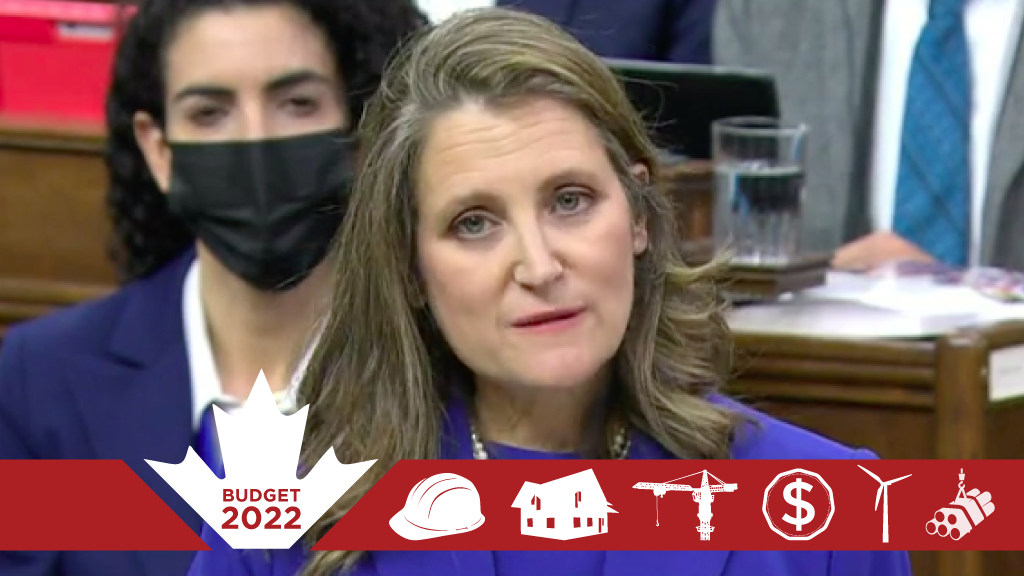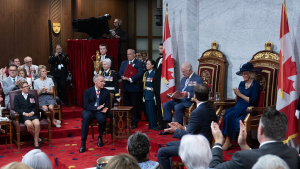In her second budget as federal Finance Minister, Chrystia Freeland announced a battery of measures to boost housing supply and affordability, introduced a $15-billion Growth Fund to attract private sector investment in key sectors of the economy, and at long last delivered on a promise to support labour mobility.
Freeland tabled the budget, billed as A Plan to Grow Our Economy and Make Life More Affordable, in the House of Commons April 7.
The minister revealed the federal deficit is projected to be $113.8 billion for fiscal year 2021-22, down from the $144.5 billion estimated in the December fiscal update. Despite significant new social and defence spending, the deficit is projected to further decline in 2022-23 to $52.8 billion and drop to $8.4 billion by 2026-27.
Freeland said the government was committed to doubling housing construction over the next decade.
“Housing is a basic human need, but it is also an economic imperative,” she said. “This budget represents the most ambitious plan that Canada has ever had to solve that fundamental challenge.”
The government has indicated it considers housing to be essential public infrastructure, for the first time linking its infrastructure spending to the willingness of lower levels of government to expedite new housing.
“Budget 2022 signals the government’s intention to create flexibility within federal infrastructure programs to tie access to infrastructure funding to actions by provinces, territories and municipalities to increase housing supply where it makes sense to do so.”
This new focus would be developed through the Canada Community-Building Fund.
The finance minister outlined three pillars of economic growth. The first, referred to as Modern Supply-Side Economics, promotes economic growth through housing, immigration, skills and child care.
“These are social policies, to be sure. But, just as importantly, they are economic policies too,” she said.
The skills and labour package includes the Labour Mobility Deduction, long sought by Canada’s Building Trades Unions, and a doubling of funding for the Union Training and Innovation Program, targeted to support apprentices from underrepresented groups.
Focus on housing
Support for housing was clearly the centrepiece of the budget. New or enhanced measures include the introduction of the Tax-Free First Home Savings Account that would give prospective first-time home buyers the ability to save up to $40,000; a doubling of the First-Time Home Buyers’ Tax Credit amount to $10,000; and a doubling of the qualifying expense limit of the Home Accessibility Tax Credit to $20,000.
Budget 2022 also delivers on a previous Liberal promise, pledging to provide $4 billion over five years to launch a new Housing Accelerator Fund that supports and offers incentives to municipalities to speed up housing development.
The new fund will target the creation of 100,000 new housing units over the next five years.
The government also proposes to extend the Rapid Housing Initiative, which funds affordable housing units; introduce a Multigenerational Home Renovation Tax Credit, which would provide up to $7,500 towards construction of a secondary suite for a senior or an adult with a disability; and support “a new generation of co-operative housing” by reallocating $500 million of funding from the National Housing Co-Investment Fund to launch a new Co-operative Housing Development Program.
Green transition
The second pillar is the green transition, supported by the new Canada Growth Fund and including new investments in critical minerals and metals that Freeland said are “essential to the green transition.”
The government will spend $3.8 billion on the Critical Minerals Strategy and there are also new provisions for carbon capture and storage.
The Growth Fund will target three dollars of private capital for every one dollar that the government invests. Spending will go to reduce emissions and contribute to achieving Canada’s climate goals; boost exports by investing in the growth of low-carbon industries and new technologies; and support the restructuring of critical supply chains.
Other green transition measures include a pledge to develop an investment tax credit of up to 30 per cent, focused on net-zero technologies, battery storage solutions and clean hydrogen; a plan to spend $150 million over five years to develop the Canada Green Buildings Strategy including building code reform; and providing $200 million over five years to create the Deep Retrofit Accelerator Initiative.
The government also aims to allot $183.2 million over seven years to the National Research Council to conduct research and development on innovative construction materials and encourage low-carbon construction solutions.
Boosting productivity
The third pillar is “a plan to tackle the Achilles heel of the Canadian economy: productivity and innovation.”
Among other measures, the government plans to create a Canadian Innovation and Investment Agency, promising $1 billion over five years to support the start-up of the fund.
Freeland also proposed a set of measure to augment Canada’s supply chain infrastructure. Spending would include $450 million over five years to support supply chain projects through the National Trade Corridors Fund.
Other infrastructure spending includes $396.8 million over two years for planning and design in support of high frequency rail between Toronto and Quebec City. The government would additionally allot $42.8 million over four years to VIA Rail Canada to construct and upgrade stations and maintenance centres in the Windsor to Quebec City corridor.
The government also announced an expansion of the role of the Canada Infrastructure Bank. The CIB will have a broadened mandate to invest in private sector-led infrastructure projects that will accelerate Canada’s transition to a low-carbon economy including small modular reactors; clean fuel production; hydrogen production; and carbon capture and storage.
Follow the author on Twitter @DonWall_DCN.











Recent Comments
comments for this post are closed